The tech world keeps changing rapidly, forcing engineers to handle more demands than ever. Users need more features, quicker releases, and better code quality while handling systems that grow more complicated by the day.
This is where agentic AI emerges, reshaping how artificial intelligence supports development work. These systems stand apart from regular automation tools that follow programmed instructions. Instead, agentic AI can evaluate situations, take action independently, and function as genuine teammates alongside developers in the creative process.
What is Agentic AI? (And Why It Matters for Developers)
Agentic AI describes self-operating, purpose-focused systems that can tackle problems independently without constant human supervision. Experts in the field note that these systems have supercharged reasoning and execution capabilities that fundamentally change how humans and machines work together. What sets agentic AI apart from standard AI is that it doesn’t just react to commands – it can strategize, understand complicated work processes, and make the first move when needed.
What distinguishes agentic AI from traditional automation is its ability to:
- Make decisions autonomously based on context and objectives.
- Plan and execute multi-step tasks without continuous human guidance.
- Learn from interactions and improve over time.
- Use reasoning capabilities to solve novel problems.
- Adapt to changing environments and requirements.
Agentic AI combines the flexibility and creativity of large language models (LLMs) with the precision and reliability of traditional programming.
How Agentic AI Boosts Developer Productivity
The impact of agentic AI on engineering productivity goes far beyond simple task automation. Here’s how these systems are fundamentally transforming the development workflow:
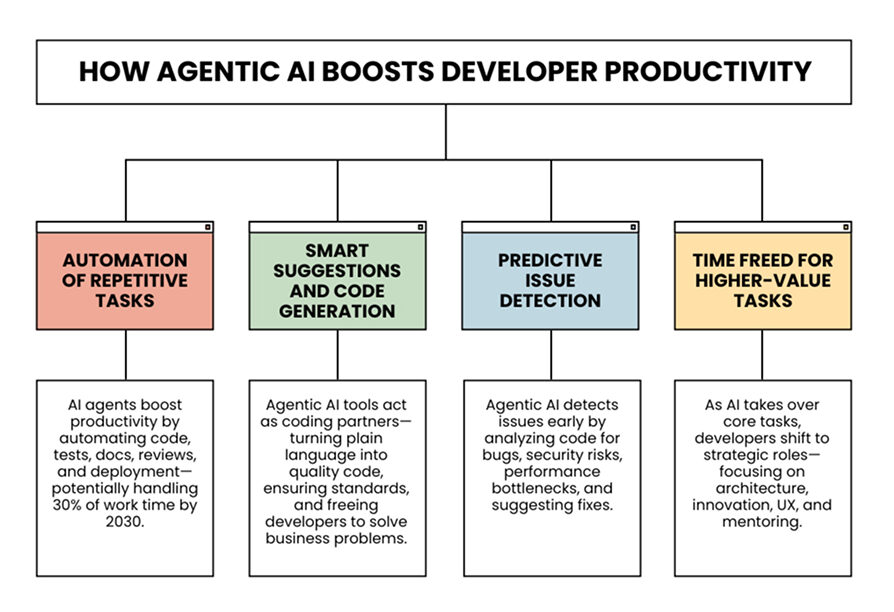
1. Automation of Repetitive Tasks
Software engineering teams implementing AI agents have seen dramatic efficiency gains, with projections suggesting AI could automate up to 30% of work hours by 2030. This automation goes well beyond simple code suggestions to handling complex, time-consuming tasks like:
- Writing boilerplate code and repetitive patterns.
- Generating unit tests with comprehensive coverage.
- Automating developer documentation updates.
- Managing code reviews and identifying potential issues.
- Handling deployment and operational tasks.
2. Smart Suggestions and Code Generation
Current agentic AI tools do more than automate. They genuinely partner with programmers by offering relevant recommendations during coding work. These insights vary from finishing single code lines to building complete functions based on plain language explanations or notes.
AI agents boost programmer output by creating solid, streamlined code that meets project requirements and follows coding guidelines.
3. Predictive Issue Detection
One of the most valuable capabilities of agentic AI is its ability to identify potential issues before they reach production. By analyzing code patterns, historical bugs, and system architecture, these systems can:
- Flag potential security vulnerabilities.
- Identify performance bottlenecks.
- Detect edge cases that might cause failures.
- Suggest optimizations based on runtime metrics.
- Highlight inconsistencies across the codebase.
4. Time Freed for Higher-Value Tasks
As AI agents automate more core functions of the software development stack, developers’ roles are becoming more strategic. This shift means engineers can focus on the following:
- Architectural design and system planning.
- Creative problem-solving for complex challenges.
- Feature innovation and user experience improvements.
- Strategic code optimization and refactoring.
- Mentoring and knowledge sharing.
Real-World Examples: Agentic AI in Action
The transformative potential of agentic AI isn’t just theoretical. It’s already delivering tangible benefits in real engineering environments:
1. AI-Assisted Debugging
Finding and fixing bugs has always taken a significant portion of time in software development. Agentic AI systems can now:
- Analyze error patterns and trace logs to identify root causes.
- Suggest potential fixes based on similar issues in the codebase.
- Run automated tests to verify solutions.
- Learn from successful resolutions to prevent future occurrences.
2. Code Generation and Refactoring
Tools like GitHub Copilot, Amazon CodeWhisperer, and Tabnine represent early implementations of agentic AI for code generation. GitHub Copilot integrates with popular code editors and uses OpenAI’s models to predict and suggest entire lines or blocks of code, streamlining the development process across various programming languages.
According to reports, AWS CodeWhisperer has led to a 57% boost in developer productivity and a 27% improvement in project success rates. These tools are particularly effective for:
- Implementing standard patterns and algorithms.
- Converting natural language requirements into functional code.
- Refactoring existing code to improve quality and maintainability.
- Adapting code to new frameworks or language versions.
3. AI Pair Programming
The concept of pair programming, where two developers work together on the same code, has proven productivity benefits. Agentic AI is now enabling a new form of pair programming where the AI acts as the second developer by:
- Providing real-time feedback and suggestions as code is written.
- Offering alternative approaches to solving problems.
- Explaining complex code sections on demand.
- Maintaining awareness of the entire codebase for context.
Stack Overflow studies have shown that AI pair programming can transform software development into a collaborative process where “the AI agent executes against the goal and constraints specified by the human user.”
Essential AI Tools for Developers Today
Several AI tools are leading the transformation of developer workflows. Each offers unique capabilities while contributing to the overall productivity enhancement promised by agentic AI.
1. GitHub Copilot
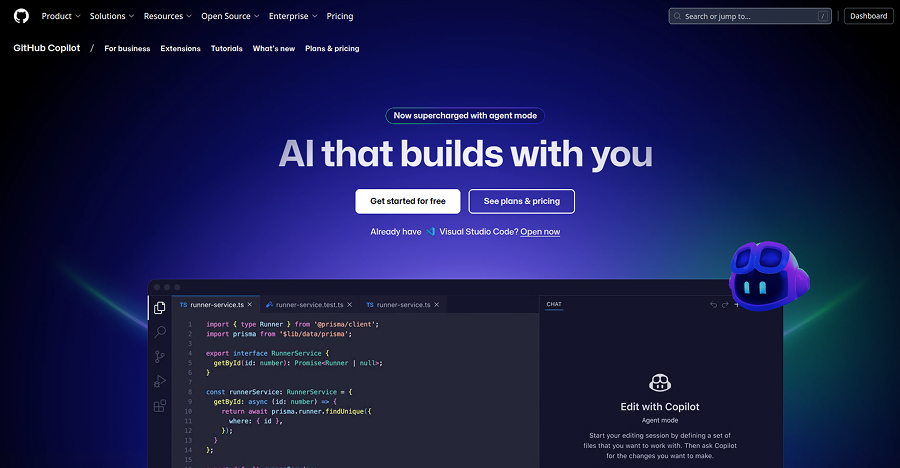
GitHub Copilot provides real-time code suggestions powered by OpenAI’s technology. It offers whole-line and full-function code generation across multiple programming languages with strong context awareness by analyzing entire codebases. Its key features include:
- Natural language to code translation.
- Context-aware code completion.
- Support for multiple programming languages.
- Integration with popular IDEs.
2. Amazon Q Developer
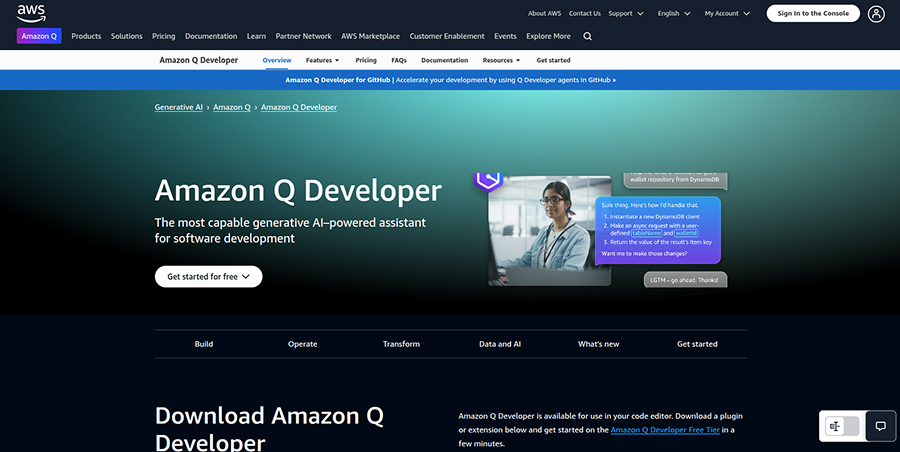
Amazon Q Developer is an AI-powered assistant designed specifically for software development within the AWS ecosystem. It offers comprehensive support throughout the development lifecycle with features including:
- Intelligent code generation optimized for AWS services and APIs.
- Real-time code suggestions with context awareness across multiple programming languages.
- Security vulnerability scanning and best practices recommendations.
- Documentation assistance for AWS services and integration patterns.
3. Tabnine

Tabnine offers significant advantages for enterprises requiring control over critical elements in their AI assistants. It gives users control over its AI code assistant through personalization and privacy settings. Its differentiators include:
- Personalized AI models based on your code.
- Self-hosting options for security-conscious teams.
- Optional offline mode for sensitive environments.
- Enterprise-focused features and controls.
4. ChatGPT

ChatGPT is a versatile AI assistant that extends beyond code generation to provide comprehensive development support across the entire software lifecycle. Its key features include:
- Natural language problem-solving for complex coding challenges.
- Debugging assistance with error analysis and solution suggestions.
- Documentation generation for code, APIs, and user guides.
- Architecture and design pattern consultation.
- Learning resources for new languages, frameworks, and concepts.
Measuring Developer Productivity in the AI Era
As AI transforms development workflows, traditional developer productivity metrics like lines of code become increasingly irrelevant. Modern engineering teams need new approaches to measuring effectiveness:
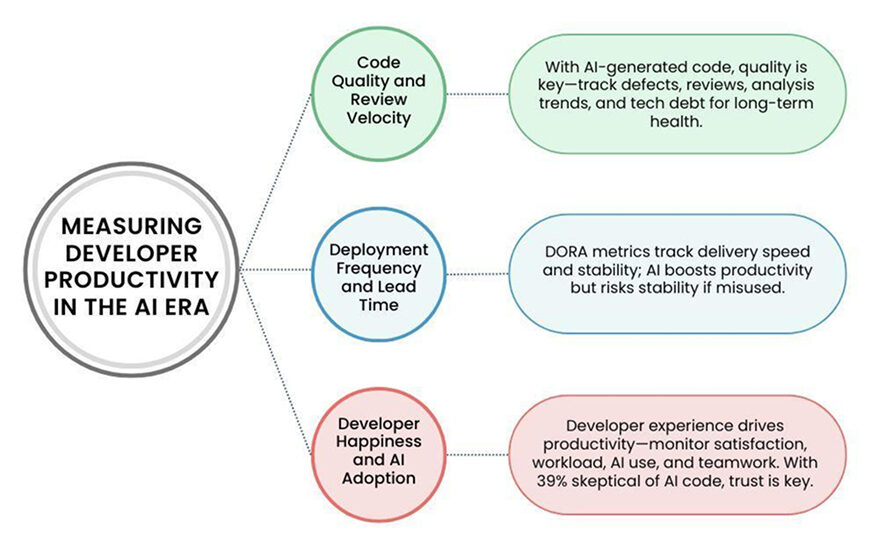
1. Code Quality and Review Velocity
With AI handling more code generation, quality becomes a more important metric than quantity. Teams should measure:
- Defect density and reduction over time.
- Code review cycle time and throughput.
- Static analysis metrics and trends.
- Technical debt identification and reduction.
2. Deployment Frequency and Lead Time
DORA metrics show how fast DevOps groups can adapt to new situations, how often they update their work, and what happens when things break. The four main measurements are:
- Deployment frequency: How often code is deployed to production.
- Lead time for changes: Time from code commit to production deployment.
- Change failure rate: Percentage of deployments causing production failures.
- Time to restore service: Time to recover from failures.
3. Developer Happiness and AI Adoption
Developer experience is increasingly recognized as a critical factor in productivity. Metrics to track include:
- Developer satisfaction surveys.
- Time spent on creative vs. routine tasks.
- Effective use of AI tools and features.
- Knowledge sharing and collaboration metrics.
Despite productivity gains, studies show that 39% of developers report less trust in AI-generated code, indicating a need to manage AI integration thoughtfully. Building trust and confidence in AI tools should be a priority for engineering leaders.
Strategies to Maximize Developer Productivity with AI
To fully realize the benefits of agentic AI, organizations should adopt strategic approaches to implementation and adoption:
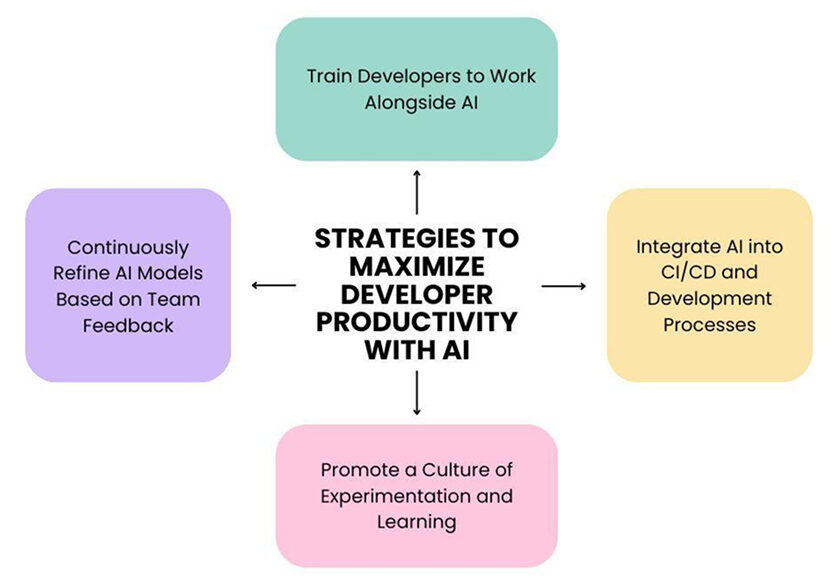
1. Train Developers to Work Alongside AI
Success with AI tools requires a shift in how developers approach their work:
- Provide structured training on effective prompting techniques.
- Share best practices for validating and reviewing AI suggestions.
- Develop guidelines for when to use (and when not to use) AI assistance.
- Create feedback loops to improve AI usage over time.
2. Integrate AI into CI/CD and Development Processes
Rather than treating AI as a separate tool, embed it throughout the development lifecycle:
- Incorporate AI code review into continuous integration pipelines.
- Use AI for automated test generation and maintenance.
- Implement AI-driven monitoring and incident response.
- Utilize AI for documentation generation and updates.
4. Continuously Refine AI Models Based on Team Feedback
The most effective AI implementations evolve based on actual usage patterns:
- Collect feedback on AI suggestions and their usefulness.
- Track acceptance rates of AI-generated code.
- Identify areas where AI consistently underperforms.
- Adjust training and fine-tuning based on real-world results.
5. Promote a Culture of Experimentation and Learning
Organizations should encourage continuous exploration of AI tools and provide developers with dedicated time for experimentation while promoting trust through hands-on experience. This culture shift includes:
- Creating safe spaces to try AI approaches.
- Celebrating and sharing AI success stories.
- Establishing communities of practice around AI tools.
- Recognizing and rewarding innovative AI applications.
Wrapping Up
Agentic AI is now an essential developer tool. It provides intelligent assistance, allowing humans to focus on more conceptual work instead of spending excessive time on coding. Many studies have shown that it increases developer efficiency and helps in delivering the project on time.
However, many developers still hesitate to adopt these technologies, which require careful integration and cultivating a culture that values both technology and human creativity.
The most forward-looking companies are figuring out how to treat AI as a partner, not a substitute for their engineering team. Any team that can effectively combine human expertise and AI will have a competitive advantage, building faster, better software with the same quality.


